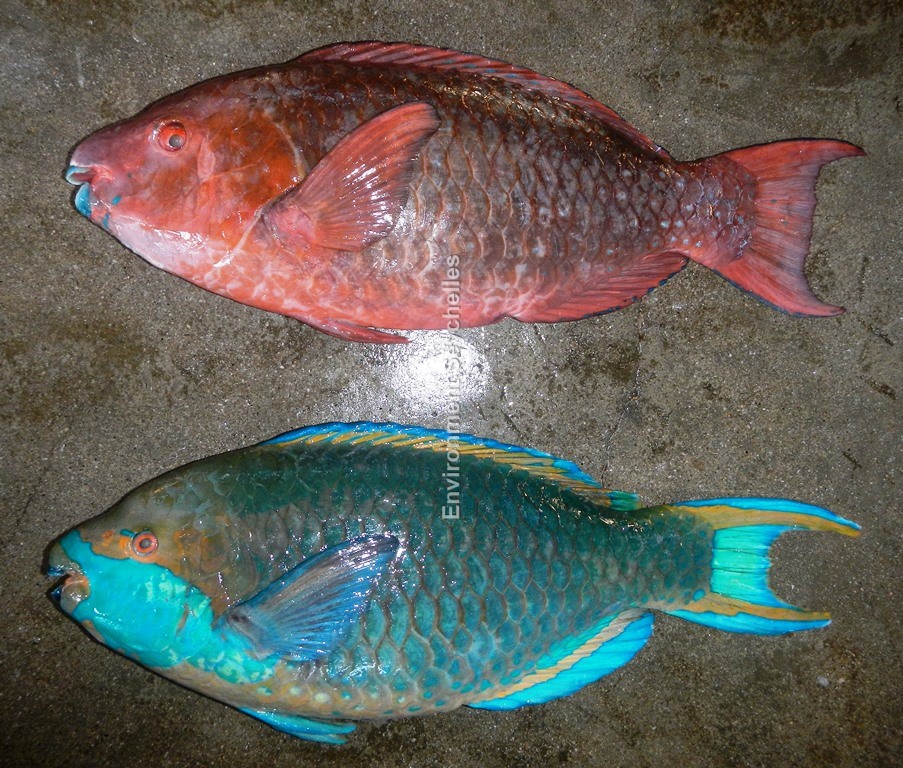Description:
Dorsal spines 9, dorsal rays 10. Anal spines 3, anal rays 9.
Lips cover ½ to ¾ of dental plate. Initial phase fish with no canine teeth on dental plates. Terminal males with one or two conical teeth posteriorly on
side of upper dental plate. Caudal fin of small initial phase truncate, becoming moderately emarginate on large individuals; caudal fin of terminal males
lunate with prolonged lobes.
Initial phase: reddish brown body, shading to reddish ventrally, with distinctive blue/grey spots on face and flanks to caudal fin becoming more numerous
posteriorly. Dental plates white. Caudal fin truncate to emarginate with growth.
Terminal phase: dark green to green-brown body, scale edged with orange, with bright green face and belly. Green face colouration branches anteriorly
to a band to snout and one to chin. Dorsal part of head dull blue green suffused with orange, the orange more evident just above the green face patch and
around the eye. A short segment of blue green extends a short distance anteriorly from the eye. Iris orange. Prominent sickle shaped caudal fin with
orange stripes on tail streamers. Dorsal fin orange with green stripes and bright blue edge. Anal fin orange with blue green base and broad outer edge.
Dental plates blue green.
Size:
Maturity: Lm unknown. Range unknown. Max Length: 60 cm TL.
(Choat, in Myers et al. 2012, cites a Seychelles’ maximum age of 10 years and size of 50 cm TL).
A 12-month survey of the parrotifsh fishery (Nevill 2020) recorded two terminal phase specimens of 52 cm TL but the vast majority of specimens
were below 48 cm TL.
Habitat and Ecology:
Inhabits coastal reefs and steep seaward reef slopes (depth 6-20 m). Feeds on benthic algae. Oviparous, distinct pairing during breeding.
Fishery Status:
This species is not protected or subject to fishery regulations. It is caught in the fish trap fishery, it is one of the more common parrotfish species
in the catch, being the 4th most common by weight in the catch. It is also caught illegally with the use of spear guns.
Notes:
Local fishers do not recognise the two phases as the same species. The initial phase is called Kakatwa labann and the terminal phase Kakatwa ver.
This species is very closely related to S. prasiognathus which largely replaces it in the eastern Indian ocean and western Pacific. S. prasiognathus has
also been recorded in the artisanal catch.
References:
Froese, R. & D. Pauly. (Eds.) (2018). FishBase. https://www.fishbase.de/summary/acanthurus-dussumieri (06/11/18).
Myers, R. et al. (2012). Scarus falcipinnis. The IUCN Red List 2012: http://dx.doi.org/10.2305/IUCN.UK.2012.RLTS.T190722A17784395.en. (19/03/19).
Nevill, J.E.G. (2020). Assessment and Valuation of the Parrotfish Fishery to Support an Ecosystem Approach to Fisheries. Project Report.
Randall, J.E. (1995). Coastal fishes of Oman. University of Hawaii Press, Honolulu.ISBN 0-8248-1808-3
Randall, J.E. & Bruce, R.W. (1983). The Parrotfishes of the Subfamily Scarinae of the Western Indian Ocean with Descriptions of Three New species.
Ichthyological Bulletin of the J.L.B. Smith Institute of Ichthyology. Number 47 March1983 ISSN: 0073-4381
Citation:
Nevill, J.E.G. (2019). Scarus falcipinnis, Sicklefin parrotfish. Seychelles Seatizens. www.seatizens.sc. https://seatizens.sc/species/scarus-falcipinnis-playfair-1868/ (updated 15/08/22).




Great post.Thanks Again. Cool.
I am so grateful for your article.Really thank you! Awesome.
Very neat blog article.Thanks Again. Great.
Very informative blog. Keep writing.
Im obliged for the article post. Really Great.
Wow, great blog.Thanks Again. Awesome.
I cannot thank you enough for the article.Really thank you! Keep writing.
Thanks for the post.Thanks Again. Keep writing.
I loved your blog article.Much thanks again. Great.
Enjoyed every bit of your article.Really thank you! Much obliged.
Very informative blog post.
Really informative post.Thanks Again. Keep writing.
Great, thanks for sharing this article.Much thanks again. Cool.
Looking forward to reading more. Great post.Much thanks again. Fantastic.
Great blog.Really thank you! Cool.
Say, you got a nice blog post.Really thank you! Really Cool.
I appreciate you sharing this post.Thanks Again.
Great, thanks for sharing this article.Thanks Again. Awesome.
I loved your blog.Much thanks again. Really Cool.